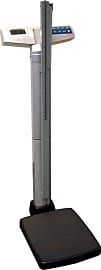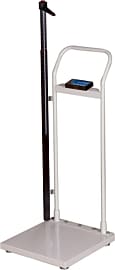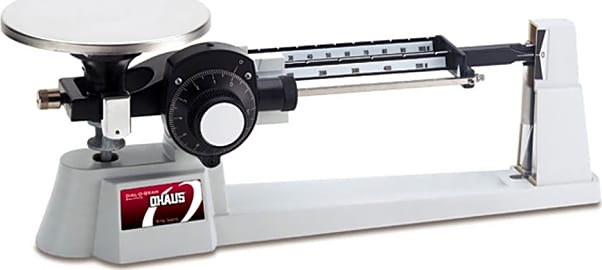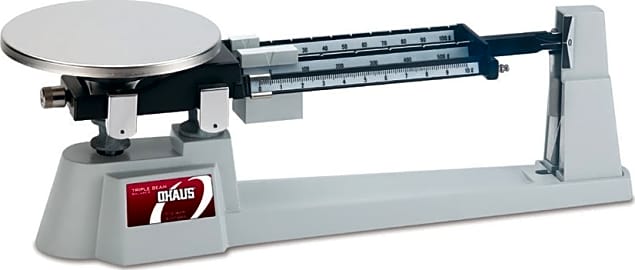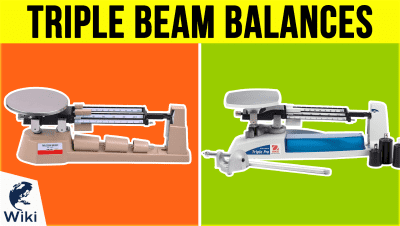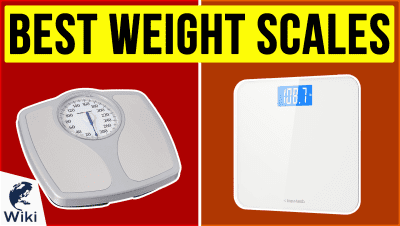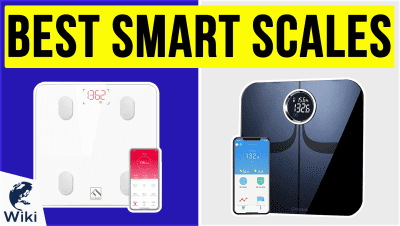The 9 Best Beam Scales

This wiki has been updated 38 times since it was first published in June of 2015. If your clinic, physician's office, or hospital needs to accurately record a patient's weight, you'll find one of these professional beam scales perfect for your business. They're also great for use in homes, especially if you're not a fan of bathroom scales, and there are also smaller versions designed for scientific and industrial measuring as well as making your own ammo. When users buy our independently chosen editorial selections, we may earn commissions to help fund the Wiki.
Editor's Notes
April 03, 2020:
There are two types of beam scales: those meant for people, and those meant for small objects. The small objects category can then be divided into two more subcategories: scientific and ammunition-focused. The Ohaus 1610-00 and Ohaus Mechanical are the most popular high-end and mid-range triple beam balances from an especially well-known manufacturer, and they're both found in quite a few homes and classrooms. The RCBS M500 is considerably more purpose-built, and as such, it't not terribly useful for anything aside from loading ammunition; when it comes to its designed task, though, it's undeniably great.
Scales meant to weigh people are an entirely different ball game. The Health O Meter 402LB is quite popular among doctor's offices, and the Health O Meter 450KL is its slightly heavier-duty relative. From the same company comes the Health O Meter 499KLHR, which is pretty expensive, but also features USB connectivity and a bright LED readout. It can be had for a little less expensive, but the version we've highlighted here has a built-in stadiometer, and if you're paying that much for a scale, you probably want it to be as full-featured as possible. The Accuro DB100 is an alternative digital model that's not nearly as expensive as the Health O Meter option, although it isn't quite as advanced, and the Seca 700 is similar to their analog models.
Special Honors
MedUsed Liquidators If you're starting your own practice, you'd do well to consider this company for stocking up on your equipment. They supply a huge variety of secondhand medical and veterinary equipment, and they make a point to ensure that it's all in good condition and ready to be shipped anywhere in the country. medused.com
A Brief History Of Scales
That all changed when the spring scale came along in the 17th century C.E., however.
For the entirety of their history, humans have had two primary enemies: adjustable-rate mortgages and scales.
Of the two, scales are much older. The earliest known models we have date back to at least 2400 B.C.E., but many experts believe they were used long before that. These were used to weigh currency, not check body fat percentages, and before their invention, it was nearly impossible to perform basic banking operations.
Those scales were simple balances, using two plates, a pole, and an overhead beam. The precious metal that was to be weighed was set on one side, with an increasing amount of weight-setting stones on the other, until the two plates were balanced.
This system, while incredible simple, was also surprisingly accurate. It had just one flaw: it was easy to cheat. All it took was a little manipulation of one of the plates, and your net worth could increase exponentially.
Despite this, balance scales were pretty much the only option available for hundreds of years. As a result, there was a tremendous amount of time and energy devoted to improving and standardizing these balances, as they were integral to the running of any well-functioning economy.
That all changed when the spring scale came along in the 17th century C.E., however. These new devices used gravity in a different way, utilizing Hooke's Law, which measured weight based on how far the spring was extended. Spring scales are still used today, primarily for weighing heavy loads such as those carried by commercial trucks.
The 20th century, meanwhile, saw the introduction of electronic models into the mix. These scales use electrical resistance to accurately determine the amount of pressure being placed on their surface. There are even devices that analyze your body composition using the same technology.
In fact, scales have become so accurate, they can even measure molecular weight. Scientists can weigh molecules one at a time by testing how much they alter the oscillating frequency of a vibrating structure.
Great — now you can find out how much weight you gained over Thanksgiving down to the molecule.
How To Use A Beam Scale
Every time you go to see your doctor, they make you stand on that awful, unfriendly scale. The nurse quickly slides a few bars around, makes a disapproving noise, and writes down your number.
But how do you know the nurse knew what he was doing? How are you supposed to double-check his work if you don't know how to use the scale yourself?
Luckily, it's surprisingly easy, once you get the hang of it.
Once the larger slider is in place, you can manipulate the smaller one to try to make the whole thing level.
When you look at the top of the scale, you should see two sliders. The larger of these corresponds to a wide increment of weight — usually about 25 pounds or so. Step on the scale and estimate how much you weigh, and move this slider to the corresponding range. Aim a little lower than what you think the actual number is (do this when you tell people how much you weigh, as well).
The smaller slider denotes individual pounds. Once the larger slider is in place, you can manipulate the smaller one to try to make the whole thing level. As it slides along the beam, you'll notice the whole thing start to fluctuate as it seeks balance. This means you're close — if it just drops like a rock to one side or the other, it's probably time to recalibrate the larger slider.
Once the scale is balanced, take the number marked by the smaller slider and add it to the weight range established on the bigger one. So, if the large slider is at 200 and the smaller one is at 15, you'd weigh 215 pounds.
For best results, try to wear as little clothing as possible, and don't fidget while trying to balance the beam. It might even be helpful to enlist someone else to move the sliders for you.
Just know that you'll have to kill them once they learn your true weight.
Digital Or Analog: Which Is More Accurate?
I've got good news for you: it's entirely possible that your scale is lying to you.
Neither digital nor analog scales are perfectly accurate, especially when you account for user error. That said, they can almost always get you close enough to the truth that you can make an informed decision about your health.
But what if it's absolutely essential that you know exactly how much you weigh? Which will get you closer to the truth?
However, the scales themselves aren't likely to throw off your measurements too much — but your mistakes are.
Unfortunately, there hasn't been a ton of effort expended in trying to find the answer. There has been one study performed which showed that digital scales were more accurate than their analog counterparts by about .5 kg, but that's just one study.
Still, it's possibly the only data point we have.
However, the scales themselves aren't likely to throw off your measurements too much — but your mistakes are. If you're not perfectly still while weighing yourself, or if the scale isn't properly calibrated, it can alter the readings significantly. That's also true if the scale isn't on a level surface.
Your familiarity with the scale itself is also important. Some digital models have so many bells and whistles that you might not be able to operate them without an engineering degree. On the other hand, if you've never dealt with an old-school beam scale before, you might have more luck with a high-tech alternative.
Digital scales are also more precise, but unless you're doing field work that requires you to measure weights down to the fourth decimal place, that much data might just serve to confuse you. Most people who are looking to track their weight loss efforts will do just fine with a machine that operates in whole numbers.
So, while the digital versions may be slightly more accurate, your comfort level with the device should be your main concern.
We mean comfort level in terms of operating the thing — you should never be comfortable when you step on one.


